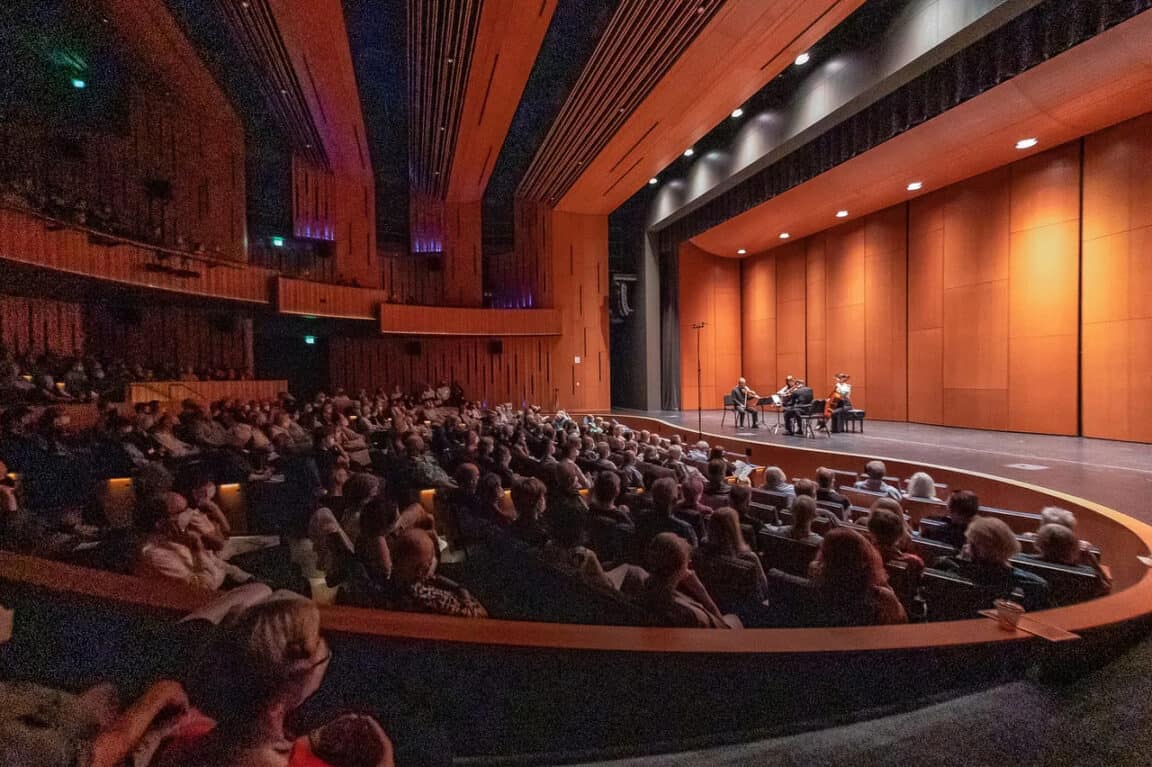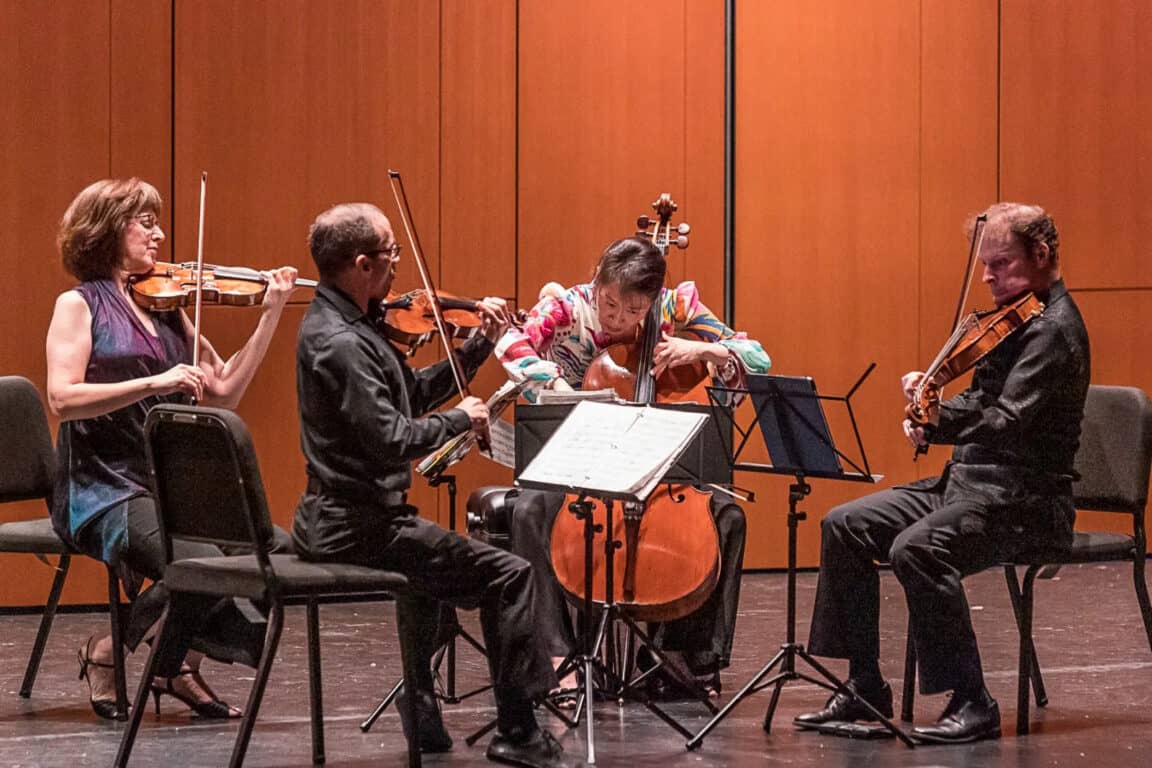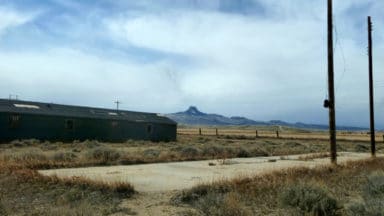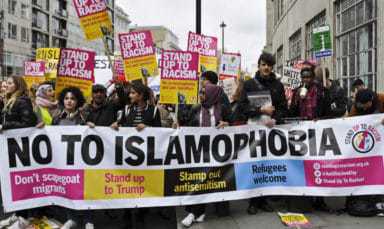Fans of the Brentano Quartet came close to filling the Patricia Reser Center for the Arts in Beaverton for Chamber Music Northwest’s July 21st concert. The audience showed its enthusiasm for the quartet–CMNW’s resident ensemble for 2021 and 2022–with a not-uncommon standing ovation at the concert’s end.
But even before the intermission, some people stood amidst loud cheering throughout the hall after a superb performance of Bartók’s Fifth String Quartet, Sz. 102. This quartet is an example of Bartok’s “arch” form, where the third movement is the centerpiece and the other four movements are arranged around it. Despite the more abstract, mathematical approach in this quartet compared to his earlier and heavier ones, the stomping of peasant dancing feet is unmistakable, especially in the third and fifth movements. In the second and fourth, the Quartet did a fine job of portraying the buzzing, whirring, and chirping of Bartok’s “night music.” In the finale, the Brentano built the rhythm to such a breathless state that there was some laughter when it was interrupted for a moment by a childish tune, after which they took us to a ferocious climax.

The Brentano’s sparkling rendition of Haydn’s String Quartet in B-flat major, Op. 33 No. 4 opened the program, as if “eating dessert first.” Their playing alternated between a fairy lightness and more serious moments, with some crazy-fast passages, always controlled, never blurred, ending with Haydn’s signature humor, in this case, a little pizzicato finish.
After the intermission, the Brentano offered Dvořák’s String Quartet No. 14 in A-flat Major, Op. 105, which the composer began while in the U.S. and finished back in his native Bohemia. Here the Quartet gave full vent to Dvořák’s sweeping romanticism. Despite the composer’s fascination with American song, those themes had no visibility in this quartet. The slow movement revealed the longing for his homeland, and the Scherzo and finale contained the folk dances he knew well — all richly played.
This concert as a whole showcased the Brentano’s superb versatility, interpreting three such different kinds of music composed in three different centuries. It also reveals the maturity of a quartet like the Brentano, whose players feel free to express their unique interpretations of the music. Not only would the composers be pleased by how faithfully the players revealed their intentions (presumed), but possibly surprised at a twist or expression that they themselves hadn’t thought of.

Dido reimagined
Kaul Auditorium at Reed College was even more packed for the Brentano’s second concert on July 23rd, when they performed a collaboration with the grammy-winning and immensely popular soprano Dawn Upshaw.
The first half of the concert consisted of English Renaissance and Baroque music originally composed for viol consorts and voice with lute accompaniment. The Quartet played these pieces with grace and spirit, as if they were second nature–despite the fact that they were written for a different set of instruments. Some of the songs by composers like Dowland and Byrd may have been familiar to those of us who grew up singing madrigals, and they were charmingly interpreted by Upshaw. In the first piece, Purcell’s lament from The Fairy Queen, it seemed a bit startling to hear such a rich operatic voice in a Baroque song. However, all the others sounded somewhat more as one would expect — cheerful and humorous for the Byrd, sweetly sad for the Dowland. The long, interweaving lines of Purcell’s Fantasia No. 4 drew us into a dark place with its nearly interminable dissonances, a very effective lead-in to Dido’s Lament as the last piece. For Dido’s passionate “Remember me, Remember me,” Upshaw’s powerful voice was enough to bring one to tears — enough to bring a crowd of people in the risers to their feet for the pre-intermission applause.

In the second half, 21st-century composer Melinda Wagner and librettist Stephanie Fleischmann gave us a very different picture of Queen Dido. Instead of a tragic character shaped by a patriarchal history, Fleischmann and Wagner have changed Dido into a modern-day heroine. Rather than committing suicide or dying on a funeral pyre, Dido lives to confront her broken heart, first with anger, then by embarking on a spiritual journey, eventually finding solace and renewal in the solitude of a windswept island surrounded by the sea.
Four epigraphs precede the libretto, setting the stage for the new Dido’s journey. A line by Roland Barthes reads: “Some lovers do not commit suicide.” A quote from Virgil evokes the queen’s memory in the rivers, mountains, and stars. The libretto is a long poem describing Dido’s journey divided into seasons, beginning with the end of summer, traversing through autumn, winter, spring, to summer again. Much of the first section is devoted to anger, where she proclaims:
I am not dead.
I did not die.
Overcome, I did not throw myself
on the funeral pyre —
In the libretto’s winter section Dido finds sisterhood in the nymph Callisto, who was raped by Jupiter, turned into a bear by Juno, and thrown into the night sky–becoming the pole star by which Dido can navigate her life. Dido recounts her journey on a bus or in a boat, paying her way or hijacking, motoring or rowing until she finally reaches her destiny:
this island overrun
with wild chamomile, asters, rosehips, goldenrod,
ancient spreading oak….
and the sea,
everywhere I turn.
Upshaw, who is known for her ability to tackle difficult contemporary music, was masterful with the intricacies of this composition. The power and flexibility of her voice matched the rigor of the score and reflected the meaning and mood of the poetry: anger to the words “No, I am not dead” and desperation when she sang “I can’t breathe, can’t sleep, can’t eat, I can’t go on.” At times she spoke the dialogue; at other times, especially toward the mysterious final stanza, her voice was almost a whisper.

The quartet playing also showed a wide range of emotion with a variety of special effects — striking the violin body with the bow, glissandos, violent articulations, and sul ponticelloscreeches. At other times it was warm and etherial, especially toward the end when Dido seems to fade into the natural world. She:
Keeps coming back
each turning day
In the crash of the waves…
the cormorants cry
the waiting heron
the swallow’s crossing….
Such a contrast between the older, more predictable landscape of the concert’s Baroque program and what can feel almost like a wilderness in this new composition can be demanding for the audience. But there could be no dispute that the diva we have heard over many years is just as capable as ever and that she and the Brentano can produce spectacular results.




